Vaccination progress and the opening up of economies
The current state of the pandemic in each respective country was presented, suggesting that infection rates have gone down quite substantially recently in all countries of the network, except in Russia which is currently facing a surge in infections driven by the delta-version of the virus. Vaccination progress is very uneven, limited by lacking access to vaccines (primarily Ukraine and Georgia) and vaccine scepticism among the population (primarily in Russia and Belarus but for certain groups also in Latvia, Poland and to some extent Sweden). This also creates challenges for governments eager to open their societies to benefit their economies and ease the social consequences of the restrictions on mobility and social gatherings. Finally, the medium to long term consequences for labour markets reveal challenges but also potential opportunities through wider availability of work–from-home policies.
Background
In many countries in Europe, citizens and governments are starting to see an end to the most intense impact of the Covid-19 pandemic on their societies. Infection and death rates are coming down and governments are starting to put in place policies for a gradual opening up of societies, as reflected in the Covid-19 stringency index developed by Oxford University. These developments are partially seasonal, but also largely a function of the progress of vaccination programs reaching an increasing share of the adult population. These developments, though, are taking place to different degrees and at different pace across countries. This is very evident at a global level, but also within Europe and among the countries represented in the FREE network. This has implications for the development within Europe as a whole, but also for the persistent inequalities we see across countries.
Short overview of the current situation
The current epidemiological situation in Latvia, Sweden, Ukraine, and Georgia looks pretty similar in terms of Covid-19 cases and deaths but when it comes to the vaccination status there is substantial variation.
Latvia experienced a somewhat weaker third wave in the spring of 2021 after being hit badly in the second wave during the fall and winter of 2020 (see Figure 1). The Latvian government started vaccinating at the beginning of 2021, and by early June, 26% of the Latvian population had been fully vaccinated.
Sweden, that chose a somewhat controversial strategy to the pandemic built on individual responsibility, had reached almost 15 thousand Covid-19 deaths by the end of June of 2021, the second highest among the FREE network member countries relative to population size. The spread of the pandemic has slowed down substantially, though, during the early summer, and the percentage of fully vaccinated is about to reach 30% of the population.
Figure 1. Cumulative Covid-19 deaths
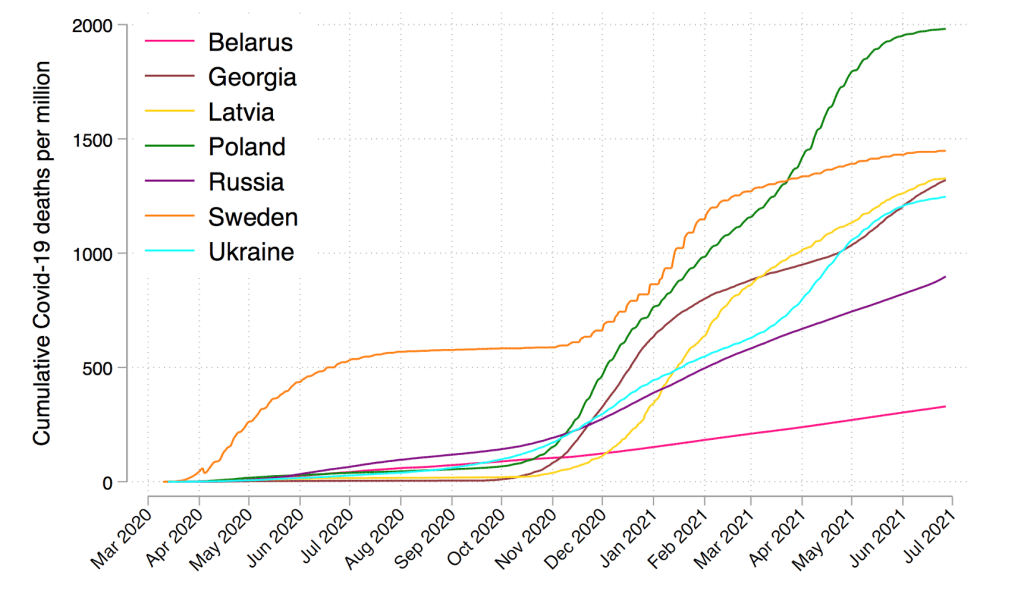
Source: Aggregated data sources from the COVID-19 Data Repository by the Center for Systems Science and Engineering (CSSE) at Johns Hopkins University, compiled by Our World in Data.
Following a severe second wave, the number of infected in Ukraine started to go down in the winter of 2020, with the total deaths settling at about 27 thousand in the month of February. Then the third wave hit in the spring, but the number of new daily cases has decreased again and is currently three times lower than at the beginning of the lastwave. However, a large part of the reduction is likely not thanks to successful epidemiological policies but rather due to low detection rates and seasonal variation.
In June 2021, Georgia faces a similar situation as Ukraine and Latvia, with the number of cumulative Covid-19 deaths per million inhabitants reaching around 1300 (in total 2500 people) following a rather detrimental spring 2021 wave. At the moment, both Georgia and Ukraine have very low vaccination coverage relative to other countries in the region(see Figure 5).
In contrast to the above countries, Russia started vaccinating early. Unfortunately, the country is now experiencing an increase in the number of cases (as can be seen in Figure 2), contrary to most other countries in the region. This negative development is likely due to the fact that the new Covid-19 delta variant is spreading in the country, particularly in Moscow and St. Petersburg. Despite the early start to vaccinations, though, the total number of vaccinated people remains low, only reaching 10.5% of the population.
Figure 2. New Covid-19 cases
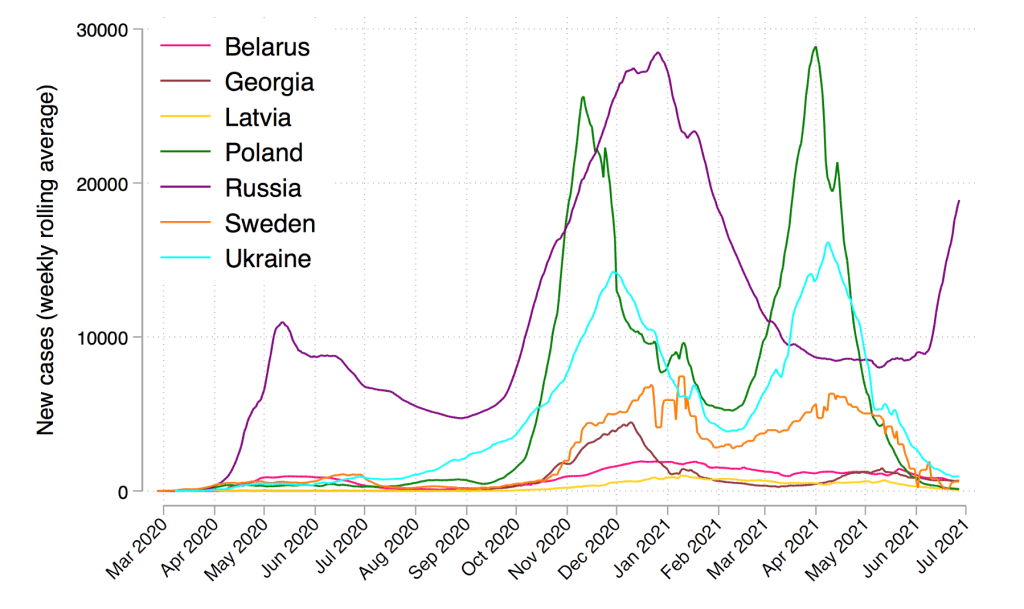
Source: Aggregated data sources from the COVID-19 Data Repository by the Center for Systems Science and Engineering (CSSE) at Johns Hopkins University, compiled by Our World in Data.
In some ways similar to Sweden, the government of Belarus did not impose any formal restrictions on individuals’ mobility. According to the official statistics, in the month of June, the rise in the cumulative number of covid-19 deaths and new daily infections has declined rapidly and reached about 400 deceased and 800 infections per one million inhabitants, respectively. Vaccination goes slowly, and by now, around 8% of the population has gotten the first dose and 5% have received the second.
There were two major waves in Poland during the autumn 2020 and spring 2021. In the latter period, the country experienced a vast number of deaths. As can be seen in Figure 3, the excess mortality P-score – the percentage difference between the weekly number of deaths in 2020-2021 and the average number of deaths over the years 2015-2019 – peaked in November 2020, reaching approximately 115%. The excess deaths numbers in Poland were also the highest among the FREE Network countries in the Spring of 2021, culminating at about 70% higher compared to the baseline. By mid-June, the number of deaths and cases have steeply declined and 36% of the country’s population is fully vaccinated.
Figure 3. Excess deaths
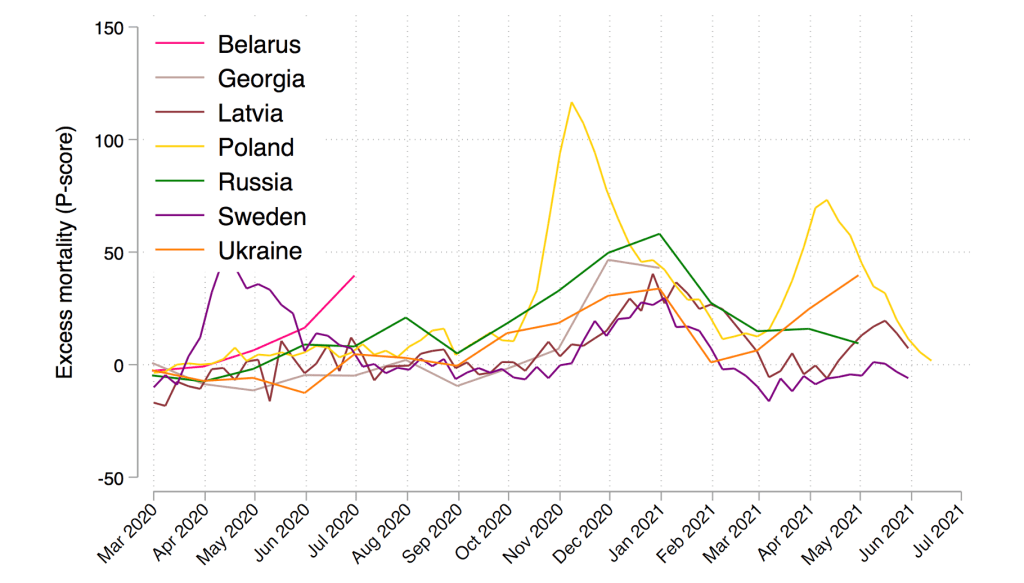
Source: Human Mortality Database & World Mortality Dataset compiled by Our World in Data.
Turning to the economy, after a devastating year, almost all countries are expected to bounce back by the end of 2021 according to the IMF (see Figure 4). Much of these predictions build on the expectations that governments across the region will lift Covid-19 restrictions. These forecasts may not be unrealistic for the countries where vaccinations have come relatively far and restrictions have started to ease. However, for countries where vaccination rates remain low and new variations of the virus is spreading, the downside risk is still very present, and forecasts contain much uncertainty.
Figure 4. GDP-growth
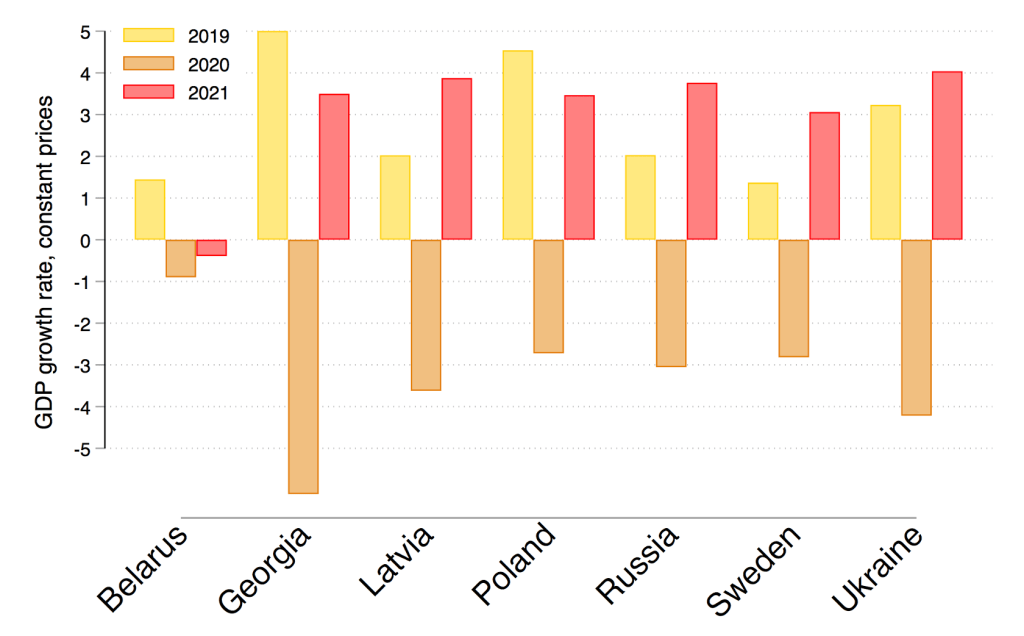
Source: IMF Economic Outlook Database, April 2021.
Vaccination challenges
Since immunization plays such a central role in re-opening the economy and society going back to normal, issues related to vaccinations were an important and recurring topic at the event. The variation in progress and speed is substantial across the countries, though.
Ukraine and Georgia are still facing big challenges with vaccine availability and have fully vaccinated only 1.3% and 2.3% of the population by the end of June, respectively. Vaccination rates have in the recent month started to pick up, but both countries face an uphill battle before reaching levels close to the more successful countries.
Figure 5. Percent fully vaccinated
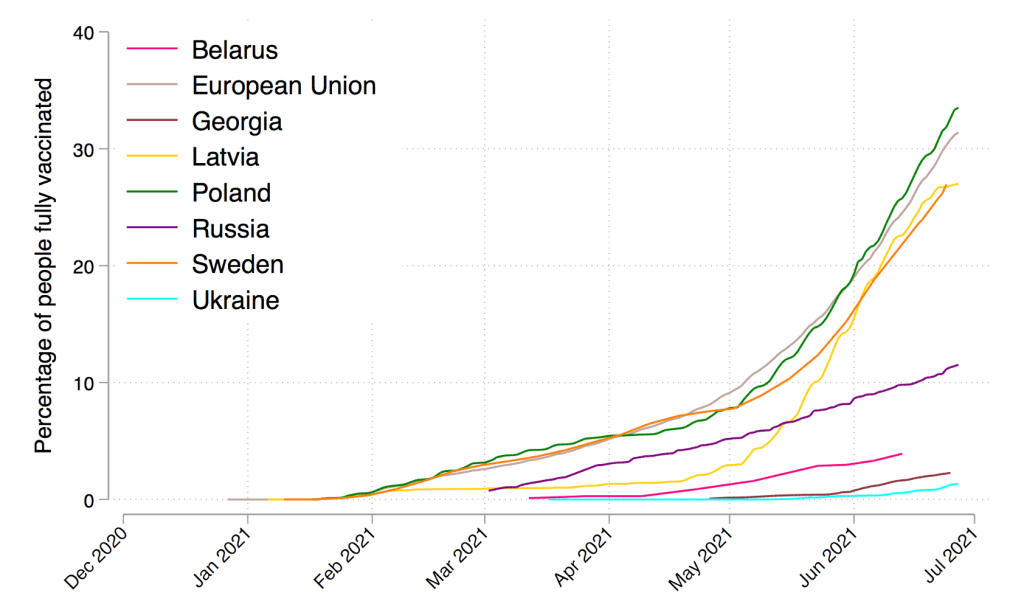
Source: Official data compiled by Our World in Data. See full source list at: github.com
Other countries a bit further ahead in the vaccine race are still facing difficulties in increasing the vaccination coverage, though not so much due to lack of availability but instead because of vaccine skepticism. In Belarus, a country that initially had bottleneck issues similar to Ukraine and Georgia, all citizens have the opportunity to get vaccinated. However, Lev Lvovskiy, Senior Research Fellow at BEROC in Belarus, argued that vaccination rates are still low largely because many Belarusians feel reluctant towards the vaccine at offer (Sputnik V).
This vaccination scepticism turns out to be a common theme in many countries. According to different survey results presented by the participants at the webinar, the percentage of people willing or planning to get vaccinated is 30% in Belarus and 44% in Russia. In Latvia, this number also varies significantly across different groups as vaccination rates are significantly lower among older age cohorts and in regions with a higher share of Russian-speaking residents, according to Sergejs Gubins, Research Fellow at BICEPS in Latvia.
Webinar participants discussed potential solutions to these issues. First, there seemed to be consensus that offering people the opportunity to choose which vaccine they get will likely be effective in increasing the uptake rate. Second, governments need to improve their communication regarding the benefits of vaccinations to the public. Several countries in the region, such as Poland and Belarus, have had statements made by officials that deviate from one another, potentially harming the government’s credibility with regards to vaccine recommendations. In Belarus, there have even been government sponsored disinformation campaigns against particular vaccines. In Latvia, the main problem is rather the need to reach and convince groups who are generally more reluctant to get vaccinated. Iurii Ganychenko, Senior Researcher at KSE in Ukraine, exemplified how Ukraine has attempted to overcome this problem by launching campaigns specifically designed to persuade certain age cohorts to get vaccinated. Natalya Volchkova, Director of CEFIR at NES in Russia, argued that new, more modern channels of information, such as professional influencers, need to be explored and that the current model of information delivery is not working.
Giorgi Papava, Lead Economist at ISET PI in Georgia, suggested that researchers can contribute to solving vaccine uptake issues by studying incentive mechanisms such as monetary rewards for those taking the vaccine, for instance in the form of lottery tickets.
Labour markets looking forward
Participants at the webinar also discussed how the pandemic has affected labour markets and whether its consequences will bring about any long-term changes.
Regarding unemployment statistics, Michal Myck, the Director of CenEA in Poland, made the important point that some of the relatively low unemployment numbers that we have seen in the region during this pandemic are misleading. This is because the traditional definition of being unemployed implies that an individual is actively searching for work, and lockdowns and other mobility restrictions have limited this possibility. Official data on unemployment thus underestimates the drop in employment that has happened, as those losing their jobs in many cases have left the labour market altogether. We thus need to see how labor markets will develop in the next couple of months as economies open up to give a more precise verdict.
Jesper Roine, Professor at SITE in Sweden, stressed that unemployment will be the biggest challenge for Sweden since its economy depends on high labor force participation and high employment rates. He explained that the pandemic and economic crisis has disproportionately affected the labor market status of certain groups. Foreign-born and young people, two groups with relatively high unemployment rates already prior to the pandemic, have become unemployed to an even greater extent. Many are worried that these groups will face issues with re-entering the labour market as in particular long-term unemployment has increased. At the same time, there have been more positive discussions about structural changes to the labour market following the pandemic. Particularly how more employers will allow for distance work, a step already confirmed by several large Swedish firms for instance.
In Russia, a country with a labour market that allowed for very little distance work before the pandemic, similar discussions are now taking place. Natalya Volchkova reported that, in Russia, the number of vacancies which assumed distance-work increased by 10% each month starting from last year, according to one of Russia’s leading job-search platforms HeadHunter. These developments could be particularly beneficial for the regional development in Russia, as firms in more remote regions can hire workers living in other parts of the country.
Concluding Remarks
It has been over a year since the Covid-19 virus was declared a pandemic by the World Health Organization. This webinar highlighted that, though vaccination campaigns in principle have been rolled out across the region, their reach varies greatly, and countries are facing different challenges of re-opening and recovering from the pandemic recession. Ukraine and Georgia have gotten a very slow start to their vaccination effort due to a combination of lack of access to vaccines and vaccine skepticism. Countries like Belarus and Latvia have had better access to vaccines but are suffering from widespread vaccine skepticism, in particular in some segments of the population and to certain vaccines. Russia, which is also dealing with a broad reluctance towards vaccines, is on top of that dealing with a surge in infections caused by the delta-version of the virus.
IMF Economic Outlook suggests that most economies in the region are expected to bounce back in their GDP growth in 2021. While this positive prognosis is encouraging, the webinar reminded us that there is a great deal of uncertainty remaining not only from an epidemiological perspective but also in terms of the medium to long-term economic consequences of the pandemic.
Participants
- Iurii Ganychenko, Senior Researcher at Kyiv School of Economics (KSE/Ukraine)
- Sergejs Gubins, Research Fellow at the Baltic International Centre for Economic Policy Studies (BICEPS/ Latvia)
- Natalya Volchkova, Director of the Centre for Economic and Financial Research at New Economic School (CEFIR at NES/ Russia)
- Giorgi Papava, Lead Economist at the ISET Policy Institute (ISET PI/ Georgia)
- Lev Lvovskiy, Senior Research Fellow at the Belarusian Economic Research and Outreach Center (BEROC/ Belarus)
- Jesper Roine, Professor at the Stockholm Institute of Transition Economics (SITE / Sweden)
- Michal Myck, Director of the Centre for Economic Analysis (CenEA / Poland)
- Anders Olofsgård, Deputy Director of SITE and Associate Professor at the Stockholm School of Economics (SITE / Sweden)
Disclaimer: Opinions expressed in policy briefs, working papers and other publications are those of the authors; they do not necessarily reflect those of SITE, the FREE Network and its research institutes.




